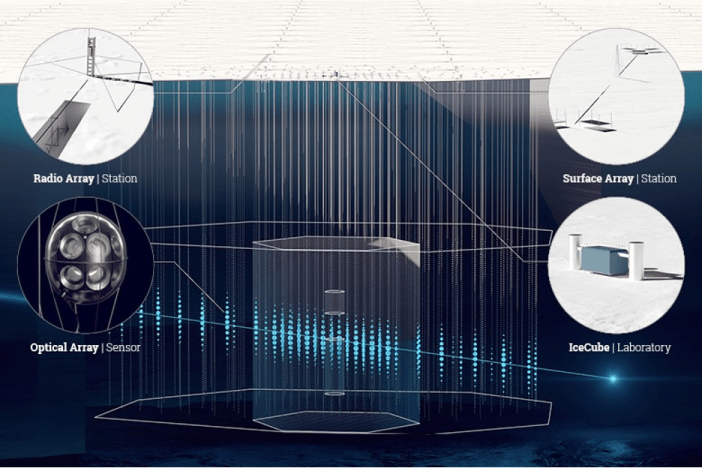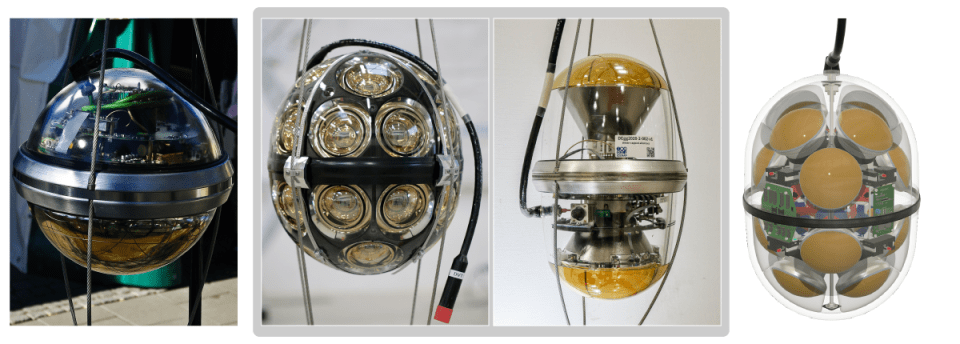The IceCube-Gen2 detectors
IceCube-Gen2, the planned extension of the IceCube Neutrino Observatory, encompasses three detector arrays that will operate in conjunction with the existing IceCube, DeepCore, and IceTop arrays as well as the low-energy IceCube Upgrade array, which is currently under construction. Therefore, once the new IceCube-Gen2 detectors are deployed, the facility will operate seven detector arrays.
- IceCube-Gen2 optical array: A huge optical array will increase the detection capabilities for high-energy astrophysical neutrinos by instrumenting eight cubic kilometers of ice at depths from 1.4 to 2.6 km adjacent to the in-ice IceCube array below the South Pole.
- IceCube-Gen2 surface array: An air shower array consisting of scintillators and radio antennas that sits on top of the footprint of the optical array will serve as a veto filter for cosmic-ray muons and will also enable improved cosmic-ray science as well as measurements of gamma rays from the Galactic Center.
- IceCube-Gen2 radio array: A shallow radio detector array covering an area of 500 km2 will increase the sensitivity to ultra-high-energy neutrinos with energies reaching the EeV scale.

A state-of-the-art, cost-efficient scientific facility
Building on the expertise of IceCube, an international team of scientists and technicians is currently preparing the final technical requirements of the IceCube-Gen2 extension. These will improve the performance of the multipurpose observatory and will increase sensitivities to levels that unleash the discovery potential of high-energy neutrinos for both astrophysics and particle physics.
The design has also been optimized to minimize construction and operation costs. While final details are still underway, scientists intend to build IceCube-Gen2 with a budget comparable to that of the initial IceCube Neutrino Observatory. Maintenance and operations will be carried out with the same personnel operating IceCube, with minimal increases in cost and in NSF facility needs at the South Pole. At this point in the design, IceCube-Gen2 construction is estimated to take eight years and cost about $350M.

The IceCube-Gen2 optical array
The IceCube-Gen2 optical array will expand the in-ice instrumented volume of the IceCube Neutrino Observatory and is designed to enhance the detection of high-energy neutrinos.
As of early 2023, the IceCube in-ice optical array, the first ever cubic-kilometer neutrino detector, consists of 80 “strings” of sensors deployed at distances of 125 meters and includes a denser infill array of six strings called DeepCore. The IceCube Upgrade will deploy seven new strings within DeepCore during the 2025-2026 Antarctic summer season. This will boost IceCube’s performance for precision measurements of neutrino physics and will also sharpen its pointing capabilities as a neutrino telescope by enabling more precise calibration of the entire IceCube detector.
With IceCube-Gen2, the addition of 120 strings of optical sensors deployed at distances of 240 meters will increase the detection volume to eight km3 and the overall sensitivity by a factor of five.
With a total of 9,600 optical sensors, IceCube-Gen2 will detect about one million neutrinos every year, which is five to ten times as many neutrinos as the current IceCube at energies above 30 TeV. In fact, neutrinos themselves are invisible to these sensors and are only observed through tracks and showers of relativistic, charged secondary particles created after the interaction of a neutrino with a molecule of ice.
The IceCube-Gen2 optical sensor design builds on the original digital optical modules, currently in the ice, and the improvements developed for the IceCube Upgrade. The new sensor will have a sensitivity three times that of an IceCube sensor and its upgraded electronics will allow for more efficient triggering and communication while significantly reducing cabling hardware.
Thanks to the IceCube-Gen2 array’s geometry and performance, the ability to resolve the double-bang signature of high-energy tau neutrinos—at and above 1 PeV—will be enhanced.

The IceCube-Gen2 surface array
With an area of about 8 km2 and an energy threshold of 0.5 PeV for cosmic-ray protons, the IceCube-Gen2 surface array will provide a veto for down-going neutrino candidates.
Combining the surface array for high-resolution measurements of cosmic-ray air showers and the deep optical array measuring bundles of TeV muons from these air showers, IceCube-Gen2 will make unique contributions to the astrophysics and particle physics of cosmic rays.
IceCube-Gen2 will expand the measurements of the Galactic cosmic-ray anisotropy to around 100 PeV. Moreover, in conjunction with the third array of detectors–the radio array–, it will also provide unprecedented measurements of the evolution of the primary composition of cosmic rays in the region of 30 PeV to several EeV where a transition from galactic to extragalactic sources is predicted.
The observations of atmospheric muons in the ice in coincidence with their parent air showers at the surface will enable a better understanding of the hadronic interactions and the study of prompt muons. PeV gamma rays are also part of the planned science and provide the potential to discover Galactic sources of cosmic rays.
The IceCube-Gen2 radio array

The IceCube-Gen2 radio array will consist of 361 detector stations spread over an area of 500 km2. This array adds a new type of detector technology to the current IceCube Neutrino Observatory, which once more takes advantage of the exceptional properties of the ice for neutrino detection.
Each station of the IceCube-Gen2 radio array consists of a cluster of antennas and is designed as an independent detector that can record the radio emission generated by particle showers resulting from the interaction of a neutrino in the ice. This group of antennas allows reconstructing not only the deposited energy but also the interaction vertex and the direction of the original neutrino.

Radio waves can travel much farther than optical photons in the ice and are able to work at shallow depths. These features make it possible to design a gigantic radio detector in Antarctica that will extend the energy range for neutrino detection by several orders of magnitude compared to IceCube. In fact, radio detection techniques may well be the most cost-effective way to explore the EeV energy frontier and connect to the ultra-high-energy cosmic ray sources. According to initial studies, the IceCube-Gen2 radio array could record about three events per year above 100 PeV, which would also provide a good test of the Standard Model at these energies.
The radio signal is produced through the Askaryan effect, where a dynamic dipole is created by an excess of relativistic electrons in the shower front and a flux of positrons along the shower axis. This charge excess travels at the speed of light in vacuum whereas the radio signal it creates propagates at the speed-of-light in ice resulting in coherent emission of radio frequency signals.
The radio detector stations come in two types: one with shallow, subsurface log-periodic dipole antennas, the other with a shallow and a deep component. The blended mix was chosen to minimize risks and ensure good data on backgrounds and systematics.
The deep cylindrical dipole antennas and slot antennas are arranged in strings at depths down to 100 meters, where they view a vast volume of ice. At EeV energies, events may be detected at distances as large as 5 km from a detector station.
While less powerful than the deep antennas, the shallow-only stations offer additional information on cosmic ray backgrounds and are easier to deploy.

